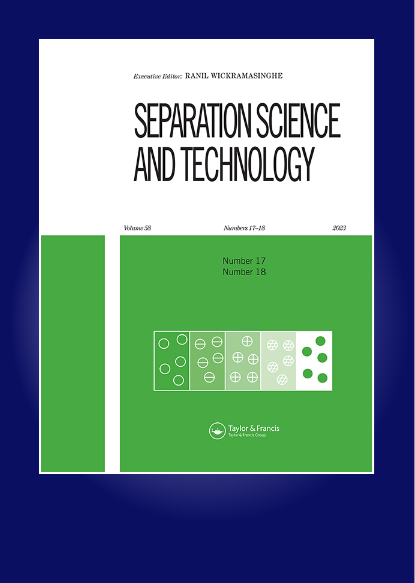CaMg(co3) 2强化氧化亚铁离子对钕溶液的有效分离
IF 2.3
4区 工程技术
Q3 CHEMISTRY, MULTIDISCIPLINARY
引用次数: 0
摘要
摘要钕铁硼磁体废产物是回收稀土元素,特别是钕的重要资源。从Nd溶液中去除铁(Fe[II])的传统方法涉及高能耗和大量使用化学品,包括氧化剂和pH调节剂,导致大量废水产生。本研究提出了一种利用CaMg(CO3)2从Nd溶液中去除Fe(II)的环保方法。在反应温度为70℃、CO32-/Fe2+比为1.5/1、反应时间为240 min、初始浓度为200 mg/L的条件下,CaMg(CO3)2表面非均相沉淀反应的Fe(II)去除率为98.6%,Nd的损失率为0.8%,可以忽略不计。结果表明,CaMg(CO3)2不仅为Fe(II)的选择性沉淀提供了适宜的碱性环境,而且在高温下显著富集了溶解氧浓度。事实上,在CaMg(CO3)2浓度为2 g/L时,溶液中溶解氧浓度在70℃时显著增加至15.5 mg/L。因此,CaMg(CO3)2的使用促进了Fe(II)向Fe(III)的快速转化,而不需要额外的氧化剂,这是去除Fe(II)而不是Nd的理想选择。关键词:CaMg(CO3) 2亚铁离子去除钕溶氧沉淀法披露声明作者未报告潜在利益冲突。本研究由江西省稀土清洁生产重点实验室(no. 1)资助。项目编号:E03MYB0302);项目编号:E055ZA01),中国科学院赣江创新研究院自主部署项目,中国科学院重点研究计划项目(no. 055za01);ZDRW-CN-2021-3),国家重点研发计划项目(批准号:ZDRW-CN-2021-3);2022 yfb3504303)。本文章由计算机程序翻译,如有差异,请以英文原文为准。
Oxidation of ferrous ions enhanced by CaMg(CO 3 ) 2 for their efficient separation from neodymium solution
ABSTRACTThe waste products of NdFeB magnets are an attractive resource for the recovery of rare earth elements (REEs), especially for neodymium [Nd]. Conventional methods employed to remove ferric (Fe[II]) from Nd solutions involve high energy consumption and the extensive use of chemicals, including oxidants and pH regulators, leading to substantial wastewater generation. In this work, an environmentally friendly approach utilizing CaMg(CO3)2 was presented to remove Fe(II) from Nd solution. Under optimized conditions, including a reaction temperature of 70°C, a CO32-/Fe2+ ratio of 1.5/1, a reaction time of 240 min, and an initial concentration of 200 mg/L, the heterogeneous precipitation reaction on the surface of CaMg(CO3)2 exhibited an exceptional Fe(II) removal efficiency of 98.6%, with a negligible loss of Nd (only 0.8%). It was observed that the CaMg(CO3)2 not only provide a suitable alkaline environment for the selective precipitation of Fe(II), but also significantly enrich the concentration of dissolved oxygen at a high temperature. In fact, at a CaMg(CO3)2 concentration of 2 g/L, the dissolved oxygen concentration in the solution increased significantly to 15.5 mg/L at 70°C. Consequently, the usage of CaMg(CO3)2 facilitated the rapid conversion of Fe(II) to Fe(III) without the need for additional oxidants, which was perfect for the removal of Fe(II) rather than Nd.KEYWORDS: CaMg(CO3)2ferrous ions removalneodymiumdissolved oxygenprecipitation Disclosure statementNo potential conflict of interest was reported by the author(s).Additional informationFundingThis study was financially supported by the Jiangxi Province Key Laboratory of Cleaner Production of Rare Earths (no. E03MYB0302), and the Research Projects of Ganjiang Innovation Academy, Chinese Academy of Sciences (no. E055ZA01), and the Self-deployed Projects of Ganjiang Innovation Academy, Chinese Academy of Sciences, and the Key Research Program of the Chinese Academy of Sciences (no. ZDRW-CN-2021-3), and the China National Key R&D Program (Grant no. 2022YFB3504303).
求助全文
通过发布文献求助,成功后即可免费获取论文全文。
去求助
来源期刊

Separation Science and Technology
工程技术-工程:化工
CiteScore
6.10
自引率
3.60%
发文量
131
审稿时长
5.7 months
期刊介绍:
This international journal deals with fundamental and applied aspects of separation processes related to a number of fields. A wide range of topics are covered in the journal including adsorption, membranes, extraction, distillation, absorption, centrifugation, crystallization, precipitation, reactive separations, hybrid processes, continuous separations, carbon capture, flocculation and magnetic separations. The journal focuses on state of the art preparative separations and theoretical contributions to the field of separation science. Applications include environmental, energy, water, and biotechnology. The journal does not publish analytical separation papers unless they contain new fundamental contributions to the field of separation science.
 求助内容:
求助内容: 应助结果提醒方式:
应助结果提醒方式:


